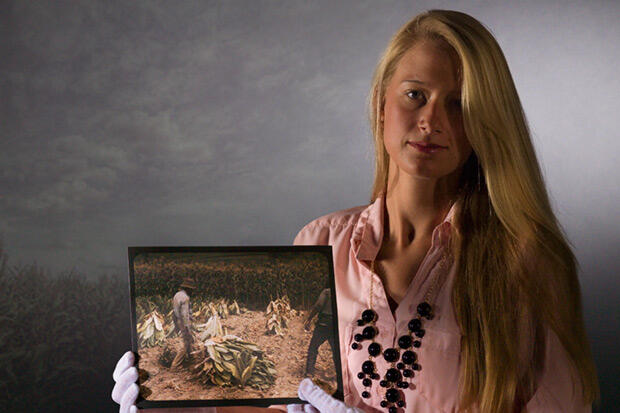
April 14, 2014
True detective: Tess Simms
English and African-American studies double major investigates the tobacco industry’s ties to slavery in the 18th and 19th centuries
Share this story
Over the past few months, Tess Simms, a senior Virginia Commonwealth University student, has been digging through historical documents and texts, finding stories that show how Richmond’s tobacco industry was intertwined with slave labor in the 18th and 19th centuries. The stories, she said, demonstrate the ways that “the tobacco industries were carried to success by enslaved people … in Richmond."
Simms, a double major in English and African-American studies from Bumpass, Va., is a research intern for Aashir Nasim, Ph.D., an associate professor of psychology and chair of VCU’s Department of African American Studies in the College of Humanities and Sciences.
As part of her internship, Simms is writing a series of research-based articles highlighting the role rural and urban slaves played in the growing and manufacturing of tobacco products in Richmond and the surrounding region.
“Her research on Richmond’s tobacco industry provides an important historical context or marker for slave rebellions in this area; and seminal events such as Henry ‘Box’ Brown’s escape to freedom that few would know to link to a well-known tobacconist in Richmond during this era,” Nasim said. “Tess’ research narrative is transdisciplinary in that it has important implications for better understanding Richmond’s culture, history and political economy.”
Her first article, “Henry ‘Box’ Brown: At the Intersection of Two Peculiar Institutions,” was posted in late February and tells the story of Henry Brown, a Richmond slave who escaped by having himself mailed in a wooden crate to abolitionists in Philadelphia. In the article, Simms describes how Brown was one of 120 slaves who worked in a Richmond tobacco factory.
“Few may know the conditions under which Brown worked and lived that finally forced him to escape the slavery-based tobacco industry,” Simms writes. “Like other enslaved men in the factory, Brown worked six days per week, ten hours per day. He was specialized in twisting tobacco, a skill that was very valuable in the 1830s tobacco market.”
According to the article, Brown’s story has ties to the modern-day tobacco industry.
“Life in the factory became especially difficult with the hiring of the overseer John F. Allen,” she writes. “Allen is best known today for his partnership with Lewis Ginter to create Allen & Ginter Tobacco Co., which eventually evolved into what’s now the Fortune 500 company Philip Morris International.”
To research her articles, Simms examined documents held by the National Archives and visited the archives of the Valentine Museum and the Virginia Historical Society. She has reviewed newspaper articles, journal articles, letters, Census records and photographs.
“It is amazing to actually sit and hold documents from the 17th century,” she said. “Such research has inspired me to maybe pursue a master’s and then a career in archival preservation.”
Simms plans to post one article per month on the Department of African American Studies website. She and Nasim have ideas for nine articles, which will be posted chronologically.
The first several stories will focus on the ties between slavery and tobacco in the 17th and 18th centuries, she said, while later installments will explore modern-day ties between African-Americans and tobacco.
“We want people to understand this connection,” she said.
Subscribe for free to the weekly VCU News email newsletter at http://newsletter.news.vcu.
Subscribe to VCU News
Subscribe to VCU News at newsletter.vcu.edu and receive a selection of stories, videos, photos, news clips and event listings in your inbox.











